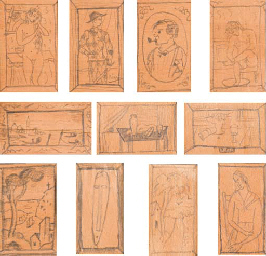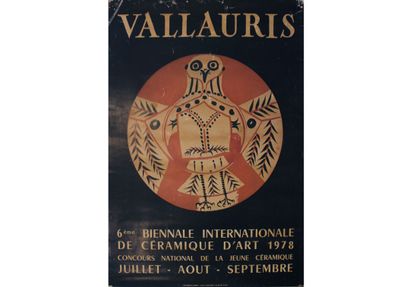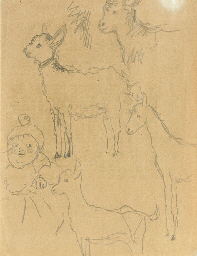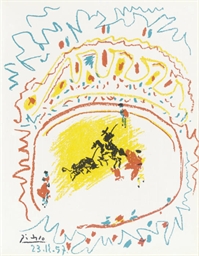Details
Pablo Picasso (1881-1973)
Femme au Fauteuil
fusain et crayon de couleurs sur papier calque
64.5 x 50 cm.
Exécuté en 1947
charcoal and coloured crayon on tracing paper
251⁄4 x 195⁄8 in.
Executed in 1947
Provenance
Atelier de l'artiste.
Marina Picasso, France (par descendance); sa vente, Sotheby's, New York, 18 mai 2017, lot 81.
Acquis au cours de cette vente par le propriétaire actuel.Exhibited
Ulm, Ulmer Museum, Pablo Picasso, In der Verwandlung, Zeichnungen und Druckgraphik aus der Sammlung Marina Picasso, octobre-décembre 1994, p. 121, no. 4 (illustré, p. 74).FURTHER DETAILS
Claude Picasso a confirmé l'authenticité de cette œuvre.
Dans la présente œuvre, Picasso exalte son amante et compagne Françoise Gilot, la transformant en une fantaisie baroque de formes organiques, tournoyantes et enveloppantes. Elle est devenue une femme-fleur virtuelle - son cou et sa tête forment le pistil d'une fleur. "Vous êtes comme une plante qui pousse", fait remarquer Picasso à Françoise, alors qu'il peint son portrait au début du mois de mai 1946, peu de temps après qu'ils aient commencé à vivre ensemble à Paris. "Je me suis demandé comment je pourrais faire passer l'idée que vous appartenez au règne végétal plutôt qu'au règne animal. Je ne me suis jamais sentie obligée de représenter quelqu'un d'autre de cette façon. C'est étrange, n'est-ce pas ? Mais je pense que c'est juste. Il vous représente" (cité dans F. Gilot et C. Lake, Life with Picasso, New York, 1964, p. 119). La guerre en Europe avait pris fin exactement deux ans auparavant ; Françoise était devenue aux yeux de Picasso l'incarnation même du printemps en temps de paix - le premier d'une décennie où le continent n'était plus pris dans les affres d'une guerre totale et existentielle. Picasso vit en sa présence la promesse excitante d'un nouveau départ dans sa vie et dans son art. Françoise était absolument essentielle à la remarquable entreprise dans laquelle Picasso s'est lancé au début de l'après-guerre, dans un contexte que Michael Fitzgerald a décrit comme "un triangle d'ambitions : l'art, la politique et la famille" (Picasso et le portrait, cat. ex., The Museum of Modern Art, New York, 1996, p. 409-445). Pour un homme d'une soixantaine d'années, déjà si profondément immergé dans l'œuvre de sa vie, ce triple engagement ambitieux aurait dû être une entreprise intimidante, qui n'a pas été entreprise à la légère. Picasso semblait désireux d'établir une nouvelle relation, plus profonde et plus durable que celle qu'il avait eue avec Dora Maar, une relation qu'il continuerait à trouver épanouissante jusqu'à un âge avancé. C'est ainsi qu'il jette son dévolu sur Françoise Gilot, une jeune femme et artiste en herbe qu'il a rencontrée pendant l'Occupation en 1943, de quarante ans sa cadette. "Sa jeunesse et sa vivacité, la couleur marron de ses yeux lumineux et son approche intelligente et autoritaire", s'enthousiasme Roland Penrose, "lui donnaient une présence à la fois arcadienne et bien de chez nous" (Picasso, His Life and Work, Berkeley, 1981, p. 358).
La présente œuvre est également très intéressante car elle rappelle à la fois le tableau Femme au fauteuil, datant de la même année, joyau du Musée Picasso de Paris, mais aussi la lithographie Femme au Fauteuil (B. 422 ; M. 69), l'une de ses expériences les plus significatives en matière d'utilisation de la couleur dans la gravure.
In the present work, Picasso exalts his lover and companion Françoise Gilot, transforming her into a baroque fantasia of twisting, circling, enveloping, organic forms. She has become a virtual femme-fleur—her neck and head form the pistil of a flower. “You’re like a growing plant,” Picasso remarked to Françoise, while painting her portrait in early May 1946, not long after they began living together in Paris. “I’ve been wondering how I could get across the idea that you belong to the vegetable kingdom rather than the animal. I’ve never felt impelled to portray anyone else this way. It’s strange, isn’t it? I think it’s just right, though. It represents you” (quoted in F. Gilot and C. Lake, Life with Picasso, New York, 1964, p. 119). The war in Europe had ended exactly two years before; Françoise had become in Picasso’s eyes the very embodiment of spring—in peacetime—the first in a decade when the continent was no longer caught up in the throes of total, existential warfare. Picasso experienced in her presence the exciting promise of a new beginning in his life and art. Françoise was absolutely essential to the remarkable endeavor upon which Picasso set forth during the early post-war years, within a context that Michael Fitzgerald delineated as “a triangle of ambitions: art, politics and the family” (Picasso and Portraiture, exh. cat., The Museum of Modern Art, New York, 1996, p. 409-445). For a man in his late sixties, already so deeply immersed in his life’s work, this ambitious, threefold commitment should have been a daunting venture, not lightly undertaken. Picasso seemed keen to establish a new, more profound and durable relationship than he had with Dora Maar, one he would continue to find fulfilling into his old age. And so he set his sights on Françoise Gilot, a young woman and aspiring artist he met during the Occupation in 1943, who was some forty years his junior. “Her youth and vivacity, the chestnut color of her luminous eyes, and her intelligent and authoritative approach,” Roland Penrose rhapsodized, “gave her a presence which was both Arcadian and very much of this earth” (Picasso: His Life and Work, Berkeley, 1981, p. 358).
The present work is also very interesting as it recalls both the Femme au fauteuil painting, dating from the same year, gem of the Musée Picasso, Paris but also the lithograph Femme au Fauteuil (B. 422; M. 69), one of his most significant experiments in using colour in printmaking.Sale Room Notice
Veuillez noter que, contrairement à ce qui a été indiqué dans le catalogue imprimé, le paragraphe H1 des Conditions de vente (droit de rétractation) ne s’applique pas à ce lot.
Please note that, contrary to what was stated in the printed catalogue, paragraph H1 of the Conditions of Sale (Right to Cancel) does not apply to this lot.
Details
Pablo Picasso (1881-1973)
Femme au Fauteuil
fusain et crayon de couleurs sur papier calque
64.5 x 50 cm.
Exécuté en 1947
charcoal and coloured crayon on tracing paper
251⁄4 x 195⁄8 in.
Executed in 1947
Provenance
Atelier de l'artiste.
Marina Picasso, France (par descendance); sa vente, Sotheby's, New York, 18 mai 2017, lot 81.
Acquis au cours de cette vente par le propriétaire actuel.Exhibited
Ulm, Ulmer Museum, Pablo Picasso, In der Verwandlung, Zeichnungen und Druckgraphik aus der Sammlung Marina Picasso, octobre-décembre 1994, p. 121, no. 4 (illustré, p. 74).FURTHER DETAILS
Claude Picasso a confirmé l'authenticité de cette œuvre.
Dans la présente œuvre, Picasso exalte son amante et compagne Françoise Gilot, la transformant en une fantaisie baroque de formes organiques, tournoyantes et enveloppantes. Elle est devenue une femme-fleur virtuelle - son cou et sa tête forment le pistil d'une fleur. "Vous êtes comme une plante qui pousse", fait remarquer Picasso à Françoise, alors qu'il peint son portrait au début du mois de mai 1946, peu de temps après qu'ils aient commencé à vivre ensemble à Paris. "Je me suis demandé comment je pourrais faire passer l'idée que vous appartenez au règne végétal plutôt qu'au règne animal. Je ne me suis jamais sentie obligée de représenter quelqu'un d'autre de cette façon. C'est étrange, n'est-ce pas ? Mais je pense que c'est juste. Il vous représente" (cité dans F. Gilot et C. Lake, Life with Picasso, New York, 1964, p. 119). La guerre en Europe avait pris fin exactement deux ans auparavant ; Françoise était devenue aux yeux de Picasso l'incarnation même du printemps en temps de paix - le premier d'une décennie où le continent n'était plus pris dans les affres d'une guerre totale et existentielle. Picasso vit en sa présence la promesse excitante d'un nouveau départ dans sa vie et dans son art. Françoise était absolument essentielle à la remarquable entreprise dans laquelle Picasso s'est lancé au début de l'après-guerre, dans un contexte que Michael Fitzgerald a décrit comme "un triangle d'ambitions : l'art, la politique et la famille" (Picasso et le portrait, cat. ex., The Museum of Modern Art, New York, 1996, p. 409-445). Pour un homme d'une soixantaine d'années, déjà si profondément immergé dans l'œuvre de sa vie, ce triple engagement ambitieux aurait dû être une entreprise intimidante, qui n'a pas été entreprise à la légère. Picasso semblait désireux d'établir une nouvelle relation, plus profonde et plus durable que celle qu'il avait eue avec Dora Maar, une relation qu'il continuerait à trouver épanouissante jusqu'à un âge avancé. C'est ainsi qu'il jette son dévolu sur Françoise Gilot, une jeune femme et artiste en herbe qu'il a rencontrée pendant l'Occupation en 1943, de quarante ans sa cadette. "Sa jeunesse et sa vivacité, la couleur marron de ses yeux lumineux et son approche intelligente et autoritaire", s'enthousiasme Roland Penrose, "lui donnaient une présence à la fois arcadienne et bien de chez nous" (Picasso, His Life and Work, Berkeley, 1981, p. 358).
La présente œuvre est également très intéressante car elle rappelle à la fois le tableau Femme au fauteuil, datant de la même année, joyau du Musée Picasso de Paris, mais aussi la lithographie Femme au Fauteuil (B. 422 ; M. 69), l'une de ses expériences les plus significatives en matière d'utilisation de la couleur dans la gravure.
In the present work, Picasso exalts his lover and companion Françoise Gilot, transforming her into a baroque fantasia of twisting, circling, enveloping, organic forms. She has become a virtual femme-fleur—her neck and head form the pistil of a flower. “You’re like a growing plant,” Picasso remarked to Françoise, while painting her portrait in early May 1946, not long after they began living together in Paris. “I’ve been wondering how I could get across the idea that you belong to the vegetable kingdom rather than the animal. I’ve never felt impelled to portray anyone else this way. It’s strange, isn’t it? I think it’s just right, though. It represents you” (quoted in F. Gilot and C. Lake, Life with Picasso, New York, 1964, p. 119). The war in Europe had ended exactly two years before; Françoise had become in Picasso’s eyes the very embodiment of spring—in peacetime—the first in a decade when the continent was no longer caught up in the throes of total, existential warfare. Picasso experienced in her presence the exciting promise of a new beginning in his life and art. Françoise was absolutely essential to the remarkable endeavor upon which Picasso set forth during the early post-war years, within a context that Michael Fitzgerald delineated as “a triangle of ambitions: art, politics and the family” (Picasso and Portraiture, exh. cat., The Museum of Modern Art, New York, 1996, p. 409-445). For a man in his late sixties, already so deeply immersed in his life’s work, this ambitious, threefold commitment should have been a daunting venture, not lightly undertaken. Picasso seemed keen to establish a new, more profound and durable relationship than he had with Dora Maar, one he would continue to find fulfilling into his old age. And so he set his sights on Françoise Gilot, a young woman and aspiring artist he met during the Occupation in 1943, who was some forty years his junior. “Her youth and vivacity, the chestnut color of her luminous eyes, and her intelligent and authoritative approach,” Roland Penrose rhapsodized, “gave her a presence which was both Arcadian and very much of this earth” (Picasso: His Life and Work, Berkeley, 1981, p. 358).
The present work is also very interesting as it recalls both the Femme au fauteuil painting, dating from the same year, gem of the Musée Picasso, Paris but also the lithograph Femme au Fauteuil (B. 422; M. 69), one of his most significant experiments in using colour in printmaking.Sale Room Notice
Veuillez noter que, contrairement à ce qui a été indiqué dans le catalogue imprimé, le paragraphe H1 des Conditions de vente (droit de rétractation) ne s’applique pas à ce lot.
Please note that, contrary to what was stated in the printed catalogue, paragraph H1 of the Conditions of Sale (Right to Cancel) does not apply to this lot.

.jpg)

.jpg)


.jpg)
_chouette_timbro_edition_picasso_;_ti_d5319095g.jpg)

.jpg)

.jpg)


.jpg)
Testen Sie LotSearch und seine Premium-Features 7 Tage - ohne Kosten!
Lassen Sie sich automatisch über neue Objekte in kommenden Auktionen benachrichtigen.
Suchauftrag anlegen